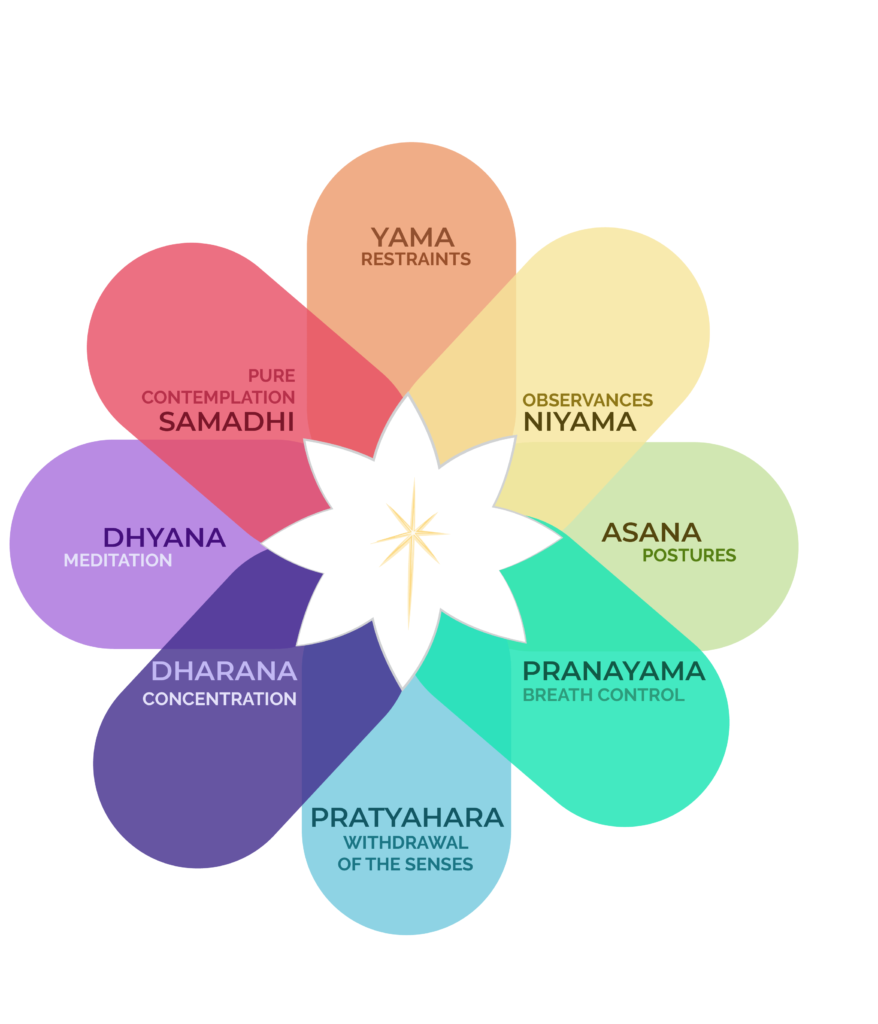
We’ve arrived!
We’ve made it to the big question that all yoga practitioners ask at some point on their path…
What is samadhi??
It’s the last stop on Patanjali’s eight-limbed path and it’s usually the one that yoga practitioners are the MOST curious about.
It’s like the highly sought after pot of gold at the end of the yoga rainbow, the ultimate aim of the whole shebang, and kinda the point of yoga practice, right?
Well if you’re confused about what exactly it is, you are DEFINITELY not alone. Understanding the concept can be as mystifying and elusive as the state itself!
I mean…is it reserved for spiritual masters?
Just how many hours do I need to meditate to achieve it?
Do I need to levitate my physical body or master every asana to do it?
So many questions!
So get ready and let’s take a tour through this mysterious part of yoga philosophy to create more clarity.
What is the state of Samadhi?

To clarify, we’ll continue to explore this through the lens of Patanjali’s eight limbs of yoga, also called Ashtanga or Classical yoga.
Remember that the lens that we’re looking through will color what we see!
This is especially true of pretty much EVERYTHING relating to yoga philosophy since there are many different lineages and the original texts are translated and interpreted differently by everyone!
For example, you will find the term samadhi used in multiple traditions but the information you find will differ based on whether you are exploring it through the view of Classical yoga, Advaita Vedanta, or Buddhism’s Noble Eightfold Path —even the root or meaning of the word itself might be different.
It’s commonly thought that samadhi is derived from the Sanskrit sam + a + dha meaning “to fully place together”.
What’s being “placed” together?
That would be
- the mind,
- the object of meditation,
- and the process of meditation itself.
This is why samadhi is often translated as “absorption” as all three of those things become absorbed into pure consciousness.
The final three limbs of yoga, dharana (“concentration”), dhyana (“meditation” that is similar to jhana in Buddhism), and samadhi (“absorption”) describe the mental process of moving from the normal state of distraction to one of single-pointed focus, and finally to one of pure absorption.
While samadhi is not actually a single state but a series of stages (more on that next!), here are some common descriptions of what samadhi is:
- The absence of fluctuations in the mind (chitta vrittis)
- Transcendence of the mind and ego
- A state of pure awareness
- The merging of ordinary consciousness with universal consciousness
- The sense of a separate individual soul is replaced with a sense oneness and connection to God, source, cosmic consciousness
- Realization of the true nature of reality
What happens in Samadhi?
There are MANY stages of samadhi according to Patanjali’s Yoga Sutras (the exact number will vary depending on who you talk to, more on that shortly).
There are two broad categories of samadhi:
- Samadhi WITH a meditation object (called sabija samadhi, savikalpa samadhi, samprajnata samadhi, and “lower samadhi”)
- Samadhi WITHOUT a meditation object (called nirbija samadhi, nirvikalpa samadhi, asamprajnata samadhi, and “higher samadhi”)
Within each of these main categories of samadhi are multiple stages. There is some debate among scholars (probably not shocking LOL) as to how the yogi progresses through these stages. I’ll share two schools of thought here.
The first school of thought is that the meditator progresses through all stages of the first category (savikalpa samadhi) before ultimately arriving at the second category (nirvikalpa samadhi). The second school of thought is that the meditator will dip into the second category as they transition between stages of the first category.
Stay with me here!
Because the good news is that both schools agree that the highest Samadhi is the second category where there is no longer a sense of the meditation object, of the self, or even of the meditation process, and that this is the pinnacle of yoga practice.
Here’s an idea of what the stages look like based on the second school of thought.
Sabija Samadhi / Savikalpa Samadhi / Samprajnata Samadhi
Here there is generally still some distinction between the meditator and the object of meditation. These are considered the earlier stages that are more attainable to dedicated practitioners. The commonly described stages of this category and their meditation objects are:
1. Savitarka samadhi – Gross object
2. Nirvitarka samadhi – Transition stage without separation between self and object
3. Savichara samadhi – Subtle object
4. Nirvichara samadhi – Transition stage without separation between self and object
5. Ananda samadhi – Sense organs and/or joy
6. Asmita samadhi – “I-am-ness”
Nirbija Samadhi / Nirvikalpa Samadhi / Asamprajnata Samadhi
Here there is no longer the distinction between the self and the meditation object, there is only consciousness. These are considered to be the later stages of samadhi that are more attainable for spiritual masters:
7. Nirvikalpa samadhi – The initial stage of more fully abiding in pure consciousness
8. Dharma megha samadhi – The transition stage before kaivalya where the meditator is said to lose even the desire to know God or to be enlightened
9. Sahaja nirvikalpa samadhi – The state of nirvikalpa samadhi that the yogi can maintain while functioning normally in the world (there is debate as to where this stage is exactly)
10. Kaivalya – Permanent absolute oneness, emancipation, aloneness, perfect detachment, directly experiencing the infinite. Believed to free the yogi from the chains of cause and effect (karma) and to be a permanent state that leaves consciousness forever altered
As the meditator’s mind becomes more engrossed in the object of meditation, they progress through the stages. For example, in earlier stages, 70% of awareness might be engaged in meditating while the remaining 30% might still be aware of a sense of self and the meditation object. With practice, 100% of consciousness can become absorbed in the object of meditation so that no faculty of mind remains to be aware of anything else.
Since only sahaja nirvikalpa samadhi and kaivalya are considered permanent stages, the rest are temporary and can last from a few seconds to a few hours or possibly days. At any moment the yogi can get distracted and drop back to an earlier stage of samadhi, dhyana, or dharana.
Some things that reportedly happen during samadhi:
- Little to no awareness of the physical body
- Seeing light while the eyes are closed
- An overflowing state of joy
- A sense of being pulled or drawn even more into deep meditation
- Supernormal abilities (levitation, clairvoyance, etc.)
- A progression from a gross experience (readily perceptible) to a subtle experience to finally losing all sense of self, time, and space
- A constant pure awareness of oneness with spirit, divine, God, that floods the entire being with bliss
How is Samadhi achieved?

The short answer: IT JUST ARISES!
Haha, okay, maybe that doesn’t seem so helpful yet, but let me explain.
If you recall from my previous post, you can’t actually just “do” dhyana, it is a state that arises on its own through consistent practice of dharana.
Make sense? Great! Because it’s the same thing with samadhi!
Samadhi is actually a “non-practice” because it arises naturally, spontaneously, and organically from dhyana.
Both dhyana and samadhi can’t be forced and it’s even believed that the better approach is yielding or allowing them to occur.
This means that of the final three limbs of Patanjali’s eight-limbed path (which Patanjali collectively called “samyama”), the only one with active “doing” is dharana.
Okay, great, Brett, so what does this mean?
It all starts with concentrating!
To attain samadhi, we practice dharana regularly. Dharana may naturally mature into dhyana and then into samadhi in time.
That being said, while you can’t simply do or achieve samadhi, what you CAN do is create the conditions for samadhi to arise.
Some things to help create the conditions for samadhi according to the Yoga Sutras and the Bhagavad Gita:
- Practice Classical Ashtanga yoga (especially yama, niyama, asana, pranayama, pratyahara, and dharana)
- Clear your karma by practicing kriya yoga (austerity, self-inquiry, surrender to God)
- According to the Bhagavad Gita, prepare the mind and the physical body with a balanced diet, balanced exercise, balanced thinking, balanced sleep, and performing your actions with balanced understanding
- Live in alignment with your dharma (purpose)
- Learn from each stage of Samyama while not attaching to any of them
Is Samadhi an enlightenment?
The journey continues!
You still with me? Because this is another big question and you’ll find lots of different answers out there because there’s confusion in the semantics (again LOL!).
First, the term “enlightenment” comes more from the Buddhist tradition, not that of Patanjali’s Classical yoga. The equivalent word from the yogic tradition is typically “liberation”. Both indicate the culmination of their respective spiritual paths.
Second, while the words “samadhi” and “enlightenment” are often used interchangeably (and often tossed around loosely in the same bucket as liberation, realization, bliss, and zen), most scholars suggest they are not exactly synonymous.
Enlightenment typically refers to a lasting state where one has permanently transcended the mind, while most stages of samadhi are temporary.
For this reason, the term “enlightenment” better equates with the lasting and highest samadhis of sahaja nirvikalpa samadhi or kaivalya.
In fact, that’s often what people REALLY mean when they speak of “samadhi”, is the final stage that leaves the yogi forever changed.
So IF we want to relate samadhi to enlightenment, it would be more accurate to say that entering the various temporary stages of samadhi is a means to reach kaivalya, which is similar to the concept of enlightenment in Buddhism.
Final thoughts
You made it! It was a bit of a winding road, hey?
Believe or not, this is just the tip of the iceberg!
It’s a massive, rich, and nebulous topic since there are relatively few people who share their direct experience of the higher stages of samadhi. And even though it’s not so black and white, part of being a yogi is learning to be okay with that!
If you really want to know more, keep studying, and more importantly, keep PRACTICING!
Because whether you are seeking liberation and enlightenment or not, meditation practice has many benefits.
If you ARE all about samadhi meditation or reaching samadhi consciousness, incorporate yogic principles into your life and serve up your dharana practice regularly along with a hearty helping of patience and persistence.
And if seeking a spiritual experience isn’t your bag, that’s great too! Contemplation and the mental process of meditation can still sharpen your intellect and hone your mindfulness so you can live more consciously, more fully savor the nectar of life, and enact more of your unique potential!
Next Steps
- If you’re interested in learning the three skills that empower you to embody your yoga off the mat to get the results you desire in your personal life, check out my Yoga for Self Mastery course.
- Explore my knowledge hub for How to Become a Yoga Teacher or consider becoming a Somatic Yoga Coach in my newest certification program.
- Practice yoga with me on my YouTube channel with over a thousand free classes.
Experience 3 Training Videos from Inside My 200-Hour Online YTT

YOU MIGHT ALSO LIKE
- What is Kriya Yoga? The Philosophy and Practice
- Uddiyana Bandha: Tapping Into Your Deep Core
- 4 Reasons Hasta Bandha Is Essential To Your Yoga Practice
- Vitarka Mudra: What It Is and How Do You Use It?
- Shakti Mudra: What It Is and How Do You Do It?
- Garuda Mudra: What It Is and How Do You Use It?
- Kali Mudra: What It Is and How Do You Do It?
- Shunya Mudra: What It Is and How Do You Do It?
- Varuna Mudra: What It Is and How Do You Use It?
- Vayu Mudra: What It Is and How Do You Use It?
- Samana Vayu: The Energy of Balance & How to Access It
- Apana Vayu: The Energy of Release & Surrender
- Udana Vayu: The Ascending Wind
- Prana Vayu: The Breath of Vitality
- Vyana Vayu: The Energetic Secret to Flow
Learn how to do 11 of the most popular yoga poses correctly. Free video + PDF download.










